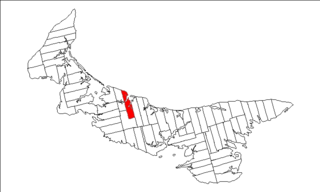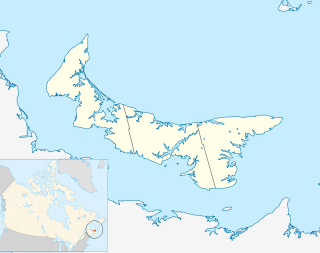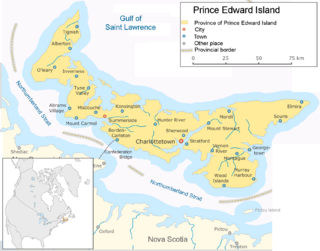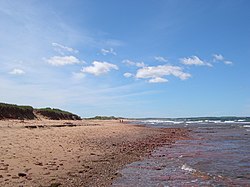
Anne of Green Gables is a 1908 novel by Canadian author Lucy Maud Montgomery. Written for all ages, it has been considered a classic children's novel since the mid-twentieth century. Set in the late 19th century, the novel recounts the adventures of Anne Shirley, an 11-year-old orphan girl, who is mistakenly sent to two middle-aged siblings, Matthew and Marilla Cuthbert, who had originally intended to adopt a boy to help them on their farm in the fictional town of Avonlea in Prince Edward Island, Canada. The novel recounts how Anne makes her way through life with the Cuthberts, in school, and within the town.

Lucy Maud Montgomery, published as L. M. Montgomery, was a Canadian author best known for a series of novels beginning in 1908 with Anne of Green Gables. The book was an immediate success. The title character, orphan Anne Shirley, made Montgomery famous in her lifetime and gave her an international following.
Avonlea is a fictional community located on Prince Edward Island, Canada, and is the setting of Lucy Maud Montgomery's novel Anne of Green Gables, following the adventures of Anne Shirley, as well as its sequels, and the television series Road to Avonlea.

Prince Edward Island National Park is a National Park of Canada located in the province of Prince Edward Island. Situated along the island's north shore, fronting the Gulf of St. Lawrence, the park measures approximately 60 km (37 mi) in length and ranges from several hundred metres to several kilometres in width. Established in 1937, the park's mandate includes the protection of many broad sand beaches, sand dunes and both freshwater wetlands and saltmarshes. The park's protected beaches provide nesting habitat for the endangered piping plover; the park has been designated a Canadian Important Bird Area.

Canada has a large domestic and foreign tourism industry. The second largest country in the world, Canada's incredible geographical variety is a significant tourist attractor. Much of the country's tourism is centred in the following (busiest) regions: Toronto, Montreal, Vancouver/Whistler, Niagara Falls, Vancouver Island, Calgary/Canadian Rockies, British Columbia's Okanagan Valley, and the national capital region Ottawa. The large cities are known for their culture, diversity, as well as the many national parks and historic sites.

Queens County is a county in the province of Prince Edward Island, Canada. It is the largest county in the province by population with 82,017 (2016), land area, and highest average income. Charlottetown is the county seat of Queens County, and is the largest city and the capital of Prince Edward Island.

Green Gables Heritage Place is a 19th century farm and literary landmark in Cavendish, Prince Edward Island, Canada. Green Gables served as the setting for the Anne of Green Gables novels by Lucy Maud Montgomery. Green Gables is recognized as a Federal Historic Building by the government of Canada, and is situated on the L.M. Montgomery's Cavendish National Historic Site of Canada. The National Historic Site itself is situated on Prince Edward Island National Park.

Lot 21 is a township in Queens County, Prince Edward Island, Canada. It is part of Greenville Parish. Lot 21 was awarded to Hugh and Lauchlin MacLeane in the 1767 land lottery. Merchant Robert Clark became owner in 1775.

Lot 22 is a township in Queens County, Prince Edward Island, Canada. It is part of Greenville Parish. Lot 22 was awarded to John Gordon and William Ridge in the 1767 land lottery.

Lot 23 is a township in Queens County, Prince Edward Island, Canada. It is part of Greenville Parish. Lot 23 was awarded to Allan and Lauchlin MacLeane in the 1767 land lottery.

Lot 24 is a township in Queens County, Prince Edward Island, Canada. It is part of Charlotte Parish. Lot 24 was awarded to Charles Lee and Francis MacLeane in the 1767 land lottery. It was sold in arrears for quitrent in 1781 and a portion was granted to Loyalists in 1783.

Anne of Green Gables (1956) is a Canadian television film directed by Don Harron. The film was based upon the 1908 novel, Anne of Green Gables by Lucy Maud Montgomery.
Belmont is a Canadian rural farming community located in the larger community of Lot 16 in central Prince County, Prince Edward Island. Lot 16 is actually three communities: Belmont, Central, and Southwest Lot 16, and is one of the last communities on Prince Edward Island to continue using their lot designation from the original Island survey by Samuel Holland in the 18th century.

Hunter River is a municipality that holds community status in Prince Edward Island, Canada. It is located in Queens County southwest of North Rustico. It is situated on the Hunter River.

The geography of Prince Edward Island is mostly pastoral with red soil, white sand, and scattered communities. Known as the "Garden of the Gulf", the island is located in the Gulf of Saint Lawrence north of Nova Scotia and east of New Brunswick, with which it forms the Northumberland Strait.

Resort Municipality, officially named the Resort Municipality of Stanley Bridge, Hope River, Bayview, Cavendish and North Rustico, is the lone municipality in Prince Edward Island, Canada that holds resort municipality status. It was established in 1990.
A resort municipality is a type of municipal status in the Canadian provinces of British Columbia and Prince Edward Island. British Columbia also has a related municipal status type of mountain resort municipality.

Prince Edward Island Route 6 is a secondary highway in central Prince Edward Island.

Rusticoville is an unincorporated rural community in the township of Lot 23, Queens County, Prince Edward Island, Canada.



















